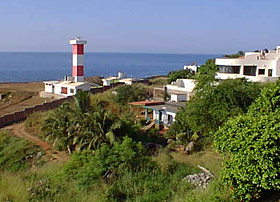 |
 |
 |
 Travel & Outdoors | October 2005 Travel & Outdoors | October 2005  
Playa Azul: Solitude at the Shore
 Christine Del Sol Christine Del Sol


| | El Faro de Caleta de Campos, Michoacán |
For a few desperate minutes the potholes and exhaust and blaring horns of the industrial port city of Lázaro Cárdenas seemed to be following us up the coast. This was not what we came for.
But, before panic set in, we reached Playa Azul, the northern anchor and only beach town of significant size along the 155-mile coastline of Michoacan state.

Mango-on-a-stick vendors walked the long, creamy beach, surfers worked the shore break and palapa restaurants lined the malecon, or seafront. Behind it, chickens and tanned locals in bathing suits strolled the unmarked dirt streets.

The half-dozen or so low-key hotels here fill with local vacationers during holidays, and a smattering of foreign visitors trickle through. But the tourism infrastructure is pretty well limited to a couple of discos and a small tourist market with vendors selling beach clothes and supplies and a small selection of crafts. Intense sunsets provide the primary evening entertainment.

Yeah. This is what we came for. Michoacan's sparsely traveled Pacific coast lies unassumingly between the resort cities of Manzanillo to the north and Ixtapa-Zihuatanejo to the south. Little has changed in 40 or 50 years along this tranquil string of white beaches fringed by coconut palms, palapas and the occasional surf shop. The price of one weekend at a destination spa will get you a week or more of relaxation here that no amount of kneading and pampering can deliver, plus a sense of serenity that comes only from slipping into a nearly forgotten way of life.

Yet aside from Morelia, the stunning capital city, most guidebooks devote no more than a page or two to Michoacan, a state more than twice the size of Hawaii. Adventurous surfers have sought their endless summers in Pacific Michoacan's waves for decades, but this slice of old Mexico is a blank slate to the average tourist.

Ironically, the success of Ixtapa-Zihuatanejo, the resort just south of the state line in the state of Guerrero that was selected and designed by government computer, has made it easier to reach the Michoacan coast. A four-lane toll road now puts the beaches within five or six hours of Morelia, and the trip will soon be even shorter when one last section of the highway is complete. Despite the progression of armadillo-, skunk-, raccoon- and squirrel-crossing signs (but none for lizards, which we saw in abundance), it's smooth driving, and the cost (a total of 246 pesos from Morelia), keeps it lightly traveled.

Gaining humidity as it loses elevation, the toll road ends at Lázaro Cárdenas, just north of Ixtapa. Highway 200 soon carried us north through coconut palms, mangroves and mango, papaya and banana orchards. It's a condo-free zone of wide-open beaches ideal for surfing, swimming, strolling or simply disappearing. Slowed by the weight of the tropical air, visitors slip inexorably into the dreamy rhythms of a lightly populated rural landscape where telephones and electricity are rare.

Even in a country where a roadway encounter with at least one wandering cow is almost a given, we were unprepared for the bovine roadblock that confronted us one morning when we rounded a palm-fringed curve.

"We've interrupted a cattle drive," I said to my travel companion. I meant it as a joke, but as we waited for six or seven cows to clear our path, about 10 more appeared. Then a dozen more, and soon cattle covered the hillside, filled the road and spilled down the slope toward the ocean. Three men appeared among them, gittin' their dogies along on foot, smiling and waving to us as they trotted past.

We'd just left Caleta de Campos, a friendly town north of Playa Azul on a bluff overlooking a large, sandy cove beach on a blue bay. The beach's palapa restaurants serve more commercial fishing launches and local families than tourists, but the town is supplied with grocery stores, surf shops, long-distance telephone stations, late-night taquerias and a pharmacy.

At Hotel Los Arcos, one of Caleta's two plain but clean hotels (only cold water not a hardship with both the temperature and the humidity hovering in the upper 80s), our room overlooked the Bahma de Bufadero blowhole, and morning brought a view of fishing boats navigating its contours and dodging its froth.

Arriving in mid-afternoon, we had to rouse the family members who run the hotel from their siesta under the palms in front of the entrance. The matriarch showed us to our room and promptly shooed us with our cameras up to the roof, where we took in the blowhole's percussions and a gilded ocean panorama punctuated by a red and white lighthouse virtually at our feet.

Making our way down to the beach, we settled at a thatched, open-air restaurant to watch children pester young men unloading fish from their pangas. A beer, quesadillas and a plate of freshcaught fish stretched into a threehour dinner that ended only when waiters started blowing out candles, which had provided the beach's sole source of light.

Highway 200 skirts the ocean to reveal inviting beaches, plunging at times through tangled trees and bushes. There are few hotels but plenty of campsites, many under the palapas where decent seafood restaurants operate. Besides the ubiquitous coconut palms and equally ubiquitous chilled coconut stands the road was thick with acacia species dripping with pea- to machete-sized pods, as well as flowering vines, bromeliads and mimosa-like trees erupting with ivory pompons.

Whether Michoacan's coast will remain a sanctuary from resort creep, or be swept up by the tourist development machine, the prudent plan is to get there soon.

christinedelsol@travelsfchronicle.com | 
 | |
 |



